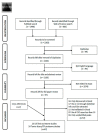Cell Line Secretome and Tumor Tissue Proteome Markers for Early Detection of Colorectal Cancer: A Systematic Review
- PMID: 29144439
- PMCID: PMC5704174
- DOI: 10.3390/cancers9110156
Cell Line Secretome and Tumor Tissue Proteome Markers for Early Detection of Colorectal Cancer: A Systematic Review
Abstract
Objective: In order to find low abundant proteins secretome and tumor tissue proteome data have been explored in the last few years for the diagnosis of colorectal cancer (CRC). In this review we aim to summarize the results of studies evaluating markers derived from the secretome and tumor proteome for blood based detection of colorectal cancer. Methods: Observing the preferred reporting items for systematic reviews and meta-analysis (PRISMA) guidelines PubMed and Web of Science databases were searched systematically for relevant studies published up to 18 July 2017. After screening for predefined eligibility criteria a total of 47 studies were identified. Information on diagnostic performance indicators, methodological procedures and validation was extracted. Functions of proteins were identified from the UniProt database and the the Quality Assessment of Diagnostic Accuracy Studies-2 (QUADAS-2) tool was used to assess study quality. Results: Forty seven studies meeting inclusion criteria were identified. Overall, 83 different proteins were identified, with carcinoembryonic Antigen (CEA) being by far the most commonly reported (reported in 24 studies). Evaluation of the markers or marker combinations in blood samples from CRC cases and controls yielded apparently very promising diagnostic performances, with area under the curve >0.9 in several cases, but lack of internal or external validation, overoptimism due to overfitting and spectrum bias due to evaluation in clinical setting rather than screening settings are major concerns. Conclusions: Secretome and tumor proteome-based biomarkers when validated in blood yield promising candidates. However, for discovered protein markers to be clinically applicable as screening tool they have to be specific for early stages and need to be validated externally in larger studies with participants recruited in true screening setting.
Keywords: colorectal cancer; early diagnosis; secretome; sensitivity; specificity; tumor tissue proteome.
Conflict of interest statement
Research on colorectal cancer screening conducted at the German Cancer Institute has been or is currently being partly funded by industrial research grants from Epigenomics, Roche Diagnostics and Applied Proteomics. None of these funders had any role in design and conduct of the study, collection, management, analysis, and interpretation of the data, and preparation, review, or approval of the manuscript.
Figures



Similar articles
-
Blood-Based Protein Signatures for Early Detection of Colorectal Cancer: A Systematic Review.Clin Transl Gastroenterol. 2017 Nov 30;8(11):e128. doi: 10.1038/ctg.2017.53. Clin Transl Gastroenterol. 2017. PMID: 29189767 Free PMC article.
-
Secretome Proteomic Approaches for Biomarker Discovery: An Update on Colorectal Cancer.Medicina (Kaunas). 2020 Aug 31;56(9):443. doi: 10.3390/medicina56090443. Medicina (Kaunas). 2020. PMID: 32878319 Free PMC article. Review.
-
Multiplex quantitation of 270 plasma protein markers to identify a signature for early detection of colorectal cancer.Eur J Cancer. 2020 Mar;127:30-40. doi: 10.1016/j.ejca.2019.11.021. Epub 2020 Jan 21. Eur J Cancer. 2020. PMID: 31972396
-
Promising Epigenetic Biomarkers for the Early Detection of Colorectal Cancer: A Systematic Review.Cancers (Basel). 2021 Oct 2;13(19):4965. doi: 10.3390/cancers13194965. Cancers (Basel). 2021. PMID: 34638449 Free PMC article. Review.
-
Biomarker discovery study of inflammatory proteins for colorectal cancer early detection demonstrated importance of screening setting validation.J Clin Epidemiol. 2018 Dec;104:24-34. doi: 10.1016/j.jclinepi.2018.07.016. Epub 2018 Aug 1. J Clin Epidemiol. 2018. PMID: 30076979 Clinical Trial.
Cited by
-
The simultaneous detection of the squamous cell carcinoma antigen and cancer antigen 125 in the cervical cancer serum using nano-Ag polydopamine nanospheres in an SERS-based lateral flow immunoassay.RSC Adv. 2020 Aug 6;10(49):29156-29170. doi: 10.1039/d0ra05207h. eCollection 2020 Aug 5. RSC Adv. 2020. PMID: 35521095 Free PMC article.
-
Locally advanced rectal cancer transcriptomic-based secretome analysis reveals novel biomarkers useful to identify patients according to neoadjuvant chemoradiotherapy response.Sci Rep. 2019 Jun 18;9(1):8702. doi: 10.1038/s41598-019-45151-w. Sci Rep. 2019. PMID: 31213644 Free PMC article.
-
Use of amantadine as substrate for SSAT-1 activity as a reliable clinical diagnostic assay for breast and lung cancer.Future Sci OA. 2018 Dec 11;5(2):FSO365. doi: 10.4155/fsoa-2018-0106. eCollection 2019 Feb. Future Sci OA. 2018. PMID: 30820345 Free PMC article.
-
Evaluation and Validation of Plasma Proteins Using Two Different Protein Detection Methods for Early Detection of Colorectal Cancer.Cancers (Basel). 2019 Sep 25;11(10):1426. doi: 10.3390/cancers11101426. Cancers (Basel). 2019. PMID: 31557860 Free PMC article.
-
Multiplex screening of 275 plasma protein biomarkers to identify a signature for early detection of colorectal cancer.Mol Oncol. 2020 Jan;14(1):8-21. doi: 10.1002/1878-0261.12591. Epub 2019 Nov 13. Mol Oncol. 2020. PMID: 31652396 Free PMC article.
References
-
- Brenner H., Stock C., Hoffmeister M. Effect of screening sigmoidoscopy and screening colonoscopy on colorectal cancer incidence and mortality: Systematic review and meta-analysis of randomised controlled trials and observational studies. BMJ. 2014;348:g2467. doi: 10.1136/bmj.g2467. - DOI - PMC - PubMed
Publication types
LinkOut - more resources
Full Text Sources
Other Literature Sources
Molecular Biology Databases

